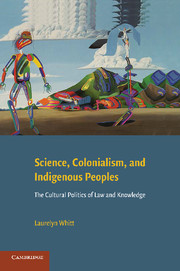Book contents
- Frontmatter
- Contents
- Preface
- Acknowledgments
- First Words
- PART I BIOCOLONIALISM AS IMPERIAL SCIENCE
- 1 Imperialism Then and Now
- 2 Indigenous Knowledge, Power, and Responsibility
- 3 Value-Neutrality and Value-Bifurcation: The Cultural Politics of Science
- PART II THE HUMAN GENOME DIVERSITY PROJECT: A CASE STUDY
- PART III LEGITIMATION: THE RULE AND ROLE OF LAW
- Conclusion – The Politics of Knowledge: Resistance and Recovery
- Bibliography
- Index
- References
1 - Imperialism Then and Now
Published online by Cambridge University Press: 04 August 2010
- Frontmatter
- Contents
- Preface
- Acknowledgments
- First Words
- PART I BIOCOLONIALISM AS IMPERIAL SCIENCE
- 1 Imperialism Then and Now
- 2 Indigenous Knowledge, Power, and Responsibility
- 3 Value-Neutrality and Value-Bifurcation: The Cultural Politics of Science
- PART II THE HUMAN GENOME DIVERSITY PROJECT: A CASE STUDY
- PART III LEGITIMATION: THE RULE AND ROLE OF LAW
- Conclusion – The Politics of Knowledge: Resistance and Recovery
- Bibliography
- Index
- References
Summary
Introduction: Some Exhibits
An exhibit, in a court of law, is anything other than oral testimony that is placed before the fact finder to be admitted as evidence in a case. This chapter opens with four exhibits, best marked for identification as diverse instances of cultural imperialism. Cultural imperialism is one of a number of oppressive relations that may hold between dominant and subordinated cultures. Whether or not conscious and intentional, it serves to extend the political power, secure the social control, and further the economic profit of the dominant culture. Ultimately, it facilitates a type of cultural acquisition via conceptual, even material, assimilation; the dominant culture seeks to establish itself in indigenous cultures by appropriating, mining, and redefining what is distinctive in, or constitutive of, them. The mechanism for this, as we will see, is an oft-repeated pattern of cultural subordination that turns vitally on legal and popular views of ownership and property, as formulated within the dominant culture.
Exhibit One records two recent events. In 1991, at a large gathering in California, a leading figure of the New Age movement announced to the assembled audience that he intended to patent the sweat lodge ceremony because native people were no longer performing it correctly. Several years later, at a meeting of indigenous support groups in Geneva, the young Europeans in attendance were informed of the passing of a respected Muskogee Creek medicine man, widely known for his defense of the right of American Indians to retain control of their own spiritual ceremonies.
- Type
- Chapter
- Information
- Science, Colonialism, and Indigenous PeoplesThe Cultural Politics of Law and Knowledge, pp. 3 - 28Publisher: Cambridge University PressPrint publication year: 2009



